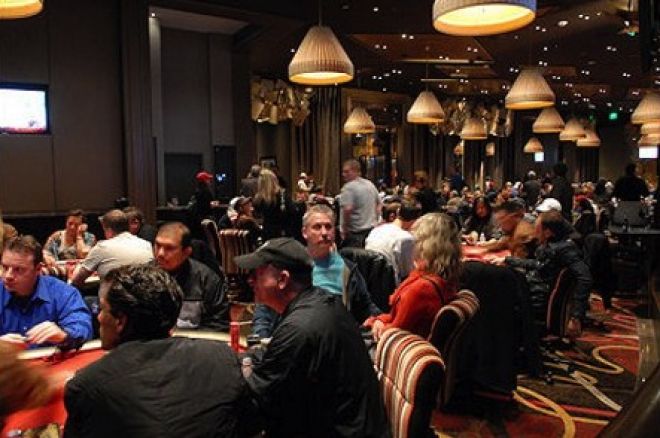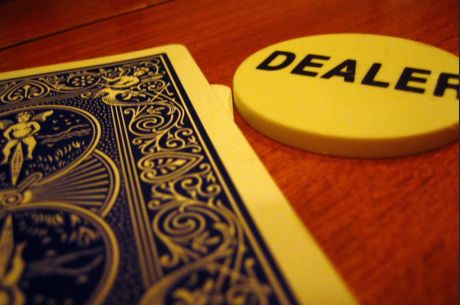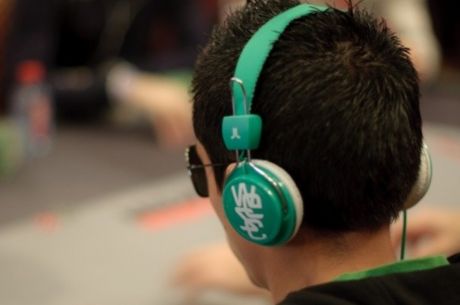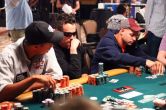Dispatches from the WSOP: Tells As Loud As Alarms

Like many poker players, Thinking Poker co-host Nate Meyvis is spending time this summer in Las Vegas playing cash games and events at the 2015 World Series of Poker.
Last night saw Meyvis survive Day 2c of the Main Event to be part of the 1,796-player field returning for today’s Day 3. The day before he spent playing cash games, and from that experience files his latest dispatch.
I was in a cash game at the Aria, and my phone suddenly went off as if it were ringing. This is surprising, as I rarely receive phone calls. The unrest was general — everyone else’s phones were going off, too.
It turned out there was a flash flood warning in Las Vegas. Some rain was coming, and rain often means flooding here, because the city simply isn’t designed to handle it. So the weather folks put out warnings loud and early.
My buddy and I wanted dinner. We could beat the rain if we left promptly, but maybe we didn’t need to. People in charge of giving warnings often have incentives to give too many warnings. Besides, sometimes smoke doesn’t mean fire. Silently, we decided simply to keep playing and to worry about the weather later.
A little later, I picked up A♥A♦ under the gun in my $2/$5 game. I made it $15, the button (who was playing far too many hands) called, and both blinds called also.
With $56 in the pot (after the rake), the flop came K♣8♣5♣. The blinds checked to me and I bet $40. It was a dangerous flop for me, but two aces is the best hand in this situation pretty often despite the large field and the three clubs. Moreover, I didn’t want the flop to be checked through. Only the button called.
He had checked his cards quickly on the flop — a classic tell, indicating that he had one club and wanted to make sure he remembered it correctly. This tell, however, is (like any other) not perfectly reliable. It’s also well known enough that it’s sometimes faked. To complicate matters, occasionally people double-check their cards in excitement after they flop a flush.
All that said, I didn’t think this was an actor — or, at least, not the sort of actor who fakes classic tells. He was a Texan, comfortable and confident at the poker table, pretty clearly successful in some line of work requiring both mental and physical competence. I wouldn’t last a full second against him in arm wrestling. I tentatively put him on a one-card flush draw, possibly with a pair.
Both blinds folded, and the turn was the 9♦. The Texan was certainly playing some hands that made two pair (or three nines) on this card, but he was playing far more hands that didn’t. If I was ahead before, I probably still was, and I didn’t think he would often bet if I checked, so I bet $75 into the $136 pot.
It seemed that he perceived the bet as bad news that he could turn into not-bad news by being fearless. That is, he seemed to perceive it as a challenge. He loudly asked how much the bet was, he counted out the amount, and he put it in the pot smoothly.
Then he looked at me as though he’d turned an advantage of mine into a disadvantage by the strength of his will. It was as if he were a student who hadn’t done the homework and who, when I called on him, had reacted with defiance instead of shame. His eyes said that, in his reckoning of things, he had trumped knowledge with moxie.
So, I was pretty sure he just had a flush draw.
The river was a pure brick, the 3♠. There was $286 in the pot. He had about twice that behind, and I covered him. If he had both a pair and a flush draw on the turn, I could bet to get him to call with the pair. That didn’t really make emotional sense, though. This guy wouldn’t do the defiant-student thing if he had a pair. In that case he’d have been happy putting all the justification for his play on the strength of his hand itself. There’d have been no reason for him to tap into his reservoir of moxie, to talk to the dealer, or to be so prompt and fluid about everything.
I guessed, then, that he didn’t even have a pair. Better to check it to him and let him either give up or bluff at it. So I checked. He immediately shrugged, reached to his chips, and grabbed a stack of red with each hand. After a half-second to secure his grip, he slid the $200 in the middle.
This was more of the same. His other “pressure bets” had often been tossed, not slid, and with higher-denomination chips instead of stacks of red — and they had been value bets. This therefore seemed to be something different from a value bet.
All this meant I had an easy call, relative to the information I just outlined. His behavior had screamed, over and over, that he was bluffing.
As I paused to think, though, I found some unease with my analysis. The shrug, the betting style, the card-checking, the stare — were they too much? Could they mean something else, perhaps that he was thrilled to have trapped a known bluffer (me), or that he was happy to have a set but aware that it couldn’t beat a flush? Or could all these harmonized signals I’d perceived have been a mere product of my desire for my aces to be holding up?
Minutes later, a few blocks away, a dozen or so tables in the Main Event would have to pick up and go to a different room — the roof was leaking. Cars were stuck; some roads were impassable. Vegas isn’t built for rain, and it was raining. Hard. The weather folks had gotten it right.
Back at the Aria, I called the bet. The button turned over his hand so fast I thought he had the winner, but it was just A♣10♥.
“I had to try to get you off your hand,” he said. I nodded, started to collect the chips, and felt some respect. It’s not every $2/$5 player who is comfortable bluffing $200 and who doesn’t show any shame when he’s caught.
Dinner would have to wait, not only because I was feeling sharp, but because the roads were best avoided for a while longer. I stacked the chips contentedly. When every alarm in the room is going off, it’s usually best to heed them.
Be sure to check out Nate and Andrew Brokos on the Thinking Poker podcast, and for more from Nate visit his blog at natemeyvis.com.
Get all the latest PokerNews updates on your social media outlets. Follow us on Twitter and find us on both Facebook and Google+!









